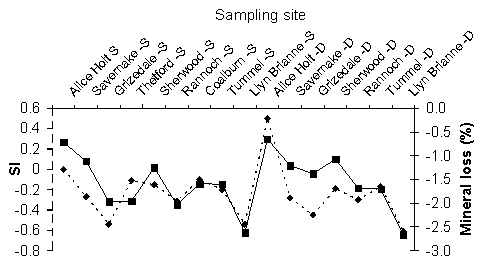Research
Research Status:current
We use some essential cookies to make this website work.
We’d like to set additional cookies to understand how you use forestresearch.gov.uk, remember your settings and improve our services.
We also use cookies set by other sites to help us deliver content from their services.
The mineralogical content of forest soils has a major influence on the calculations of both forest nutrient and pollutant budget studies. However, whilst it is possible to measure the mineralogical content within soil samples, their rates of decay and thus contribution to the soil chemistry is poorly understood.
To help address this lack of information, in 1997, 7 types of reference mineral samples were buried in a selection of different soil horizons at 10 of the Level II monitoring sites. The soil horizons were selected to provide a diverse range of chemical environments. At each site, replicate sets were buried to allow recovery at different time intervals. The buried minerals varied in their chemical stability, ranging from the highly soluble Gypsum, through Apatite, intermediate Micas minerals to the more stable Microcline and Tourmaline.
The minerals were recovered after 1, 3, 5 and 10 years.
Differences in the rates of mineral loss were seen not only between sites, but also individual soil horizons. For some of the mineral types used, chemical analysis of soil solution collected from the monitoring sites by tension lysimeters, allowed geochemical modelling of the mineral’s saturation index (SI) within the soil solution. This saturation value can be used as an indicator of the mineral’s susceptibility to dissolution or precipitation within that soil environment.
Good correlations have been found for comparative predicted rates of loss from the model with actual weight losses of mineral. An example is shown below for the mineral ‘Tourmaline’.

Final analysis of the minerals recovered after the 10-year period of this project is ongoing.
Cookies are files saved on your phone, tablet or computer when you visit a website.
We use cookies to store information about how you use the dwi.gov.uk website, such as the pages you visit.
Find out more about cookies on forestresearch.gov.uk
We use 3 types of cookie. You can choose which cookies you're happy for us to use.
These essential cookies do things like remember your progress through a form. They always need to be on.
We use Google Analytics to measure how you use the website so we can improve it based on user needs. Google Analytics sets cookies that store anonymised information about: how you got to the site the pages you visit on forestresearch.gov.uk and how long you spend on each page what you click on while you're visiting the site
Some forestresearch.gov.uk pages may contain content from other sites, like YouTube or Flickr, which may set their own cookies. These sites are sometimes called ‘third party’ services. This tells us how many people are seeing the content and whether it’s useful.